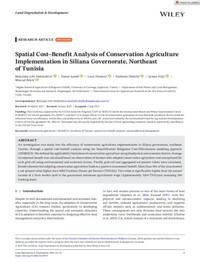Spatial Cost–Benefit Analysis of Conservation Agriculture Implementation in Siliana Governorate, Northeast of Tunisia

Authors:
An investigation was made into the efficiency of conservation agriculture implementation in Siliana governorate, northeast Tunisia, through a spatial cost–benefit analysis using the Desertification Mitigation Cost-Effectiveness modeling approach (DESMICE). We defined the applicability limitations of conservation agriculture using biophysical and economic factors. Average incremental benefit was calculated based on observations of farmers who adopted conservation agriculture and extrapolated for each grid cell using environmental and economic factors. Finally, grid cell and aggregated net present values were calculated. Results showed that adopting conservation agriculture leads to a positive incremental benefit. More than 56% of the area showed a net present value higher than 6000 Tunisian Dinars per hectare (TND/ha). This value is significantly higher than the annual income of a farm worker paid at the guaranteed minimum agricultural wage (Approximately 5284 TND/year assuming 260 working days).
